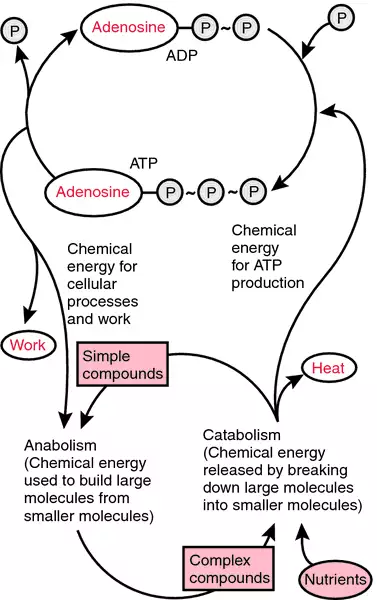adenosine
[ah-den´o-sēn]
adenosine
Pharmacologic class: Endogenous nucleoside
Therapeutic class: Antiarrhythmic
Pregnancy risk category C
Action
Converts paroxysmal supraventricular tachycardia (PSVT) to normal sinus rhythm by slowing conduction through atrioventricular (AV) node and interrupting reentry pathway. Also used as a diagnostic agent in thallium scanning.
Availability
Injection: 3 mg/ml
Indications and dosages
Adenocard-
➣ PSVT, including that associated with Wolff-Parkinson-White syndrome (after attempting vagal maneuvers, when appropriate)
Adults and children weighing more than 50 kg (110 lb): Initially, 6 mg by rapid I.V. bolus over 1 to 2 seconds. If desired effect isn't achieved within 1 to 2 minutes, give 12 mg by rapid I.V. bolus; may repeat 12-mg I.V. bolus dose as needed. Maximum single dosage is 12 mg.
Children weighing less than 50 kg (110 lb): 0.05 to 0.1 mg/kg by rapid I.V. bolus. If this dosage proves ineffective, increase in 1 to 2 minutes by 0.05 mg/kg q 2 minutes, to a maximum single dosage of 0.3 mg/kg. Maximum single dosage is 12 mg.
Adenoscan-
➣ Diagnosis of coronary artery disease in conjunction with thallium-201 myocardial perfusion scintigraphy in patients unable to exercise adequately during testing
Adults: 140 mcg/kg/minute by I.V. infusion over 6 minutes, for a total dosage of 0.84 mg/kg. Required dose of thallium-201 is injected at midpoint (after first 3 minutes) of Adenoscan infusion.
Off-label uses
• Diagnosis of supraventricular arrhythmias
• Pulmonary hypertension
Contraindications
• Hypersensitivity to drug
• Second- or third-degree AV block
• Sinus node disease
• Bronchoconstrictive lung disease
Precautions
Use cautiously in:
• asthma, angina
• elderly patients
• pregnant patients
• children.
Administration
• Don't administer through central line (may cause asystole).
• Don't give more than 12 mg Adenocard as a single dose.
• Don't dilute Adenocard. Administer Adenocard by I.V. injection as a rapid bolus directly into vein whenever possible during cardiac monitoring.
• After administering Adenocard, flush I.V. line immediately and rapidly with normal saline solution to drive drug into bloodstream.
• Dilute a single dose of Adenoscan in sufficient normal saline solution to be given by continuous infusion over 6 minutes.
Adverse reactions
CNS: light-headedness, dizziness, apprehension, headache, tingling in arms, numbness
CV: chest pain, palpitations, hypotension, ST-segment depression, first- or second-degree AV block, atrial tachyarrhythmias, other arrhythmias
EENT: blurred vision, tightness in throat
GI: nausea, pressure in groin
Musculoskeletal: discomfort in neck, jaw, and arms
Respiratory: chest pressure, dyspnea and urge to breathe deeply, hyperventilation
Skin: burning sensation, facial flushing, sweating
Other: metallic taste
Interactions
Drug-drug. Carbamazepine: worsening of progressive heart block
Digoxin, verapamil: increased risk of ventricular fibrillation
Dipyridamole: increased adenosine effect
Theophylline: decreased adenosine effect
Drug-food. Caffeine: decreased adenosine effect
Drug-herbs. Aloe, buckthorn bark or berry, cascara sagrada, rhubarb root, senna leaf or fruits: increased adenosine effect
Guarana: decreased adenosine effect
Drug-behaviors. Smoking: increased risk of tachycardia
Patient monitoring
• Monitor heart rhythm for new arrhythmias after administering dose.
• Check vital signs. Assess for chest pain or pressure, dyspnea, and sweating.
☞ Watch for bronchoconstriction in patients with asthma, emphysema, or bronchitis.
• Ask patient if he has recently used aloe, buckthorn, cascara sagrada, guarana, rhubarb root, or senna. If response is positive, notify prescriber.
Patient teaching
• Advise patient to report problems at infusion site.
• Tell patient he may experience 1 to 2 minutes of flushing, chest pain and pressure, and breathing difficulty during administration. Assure him that these effects will subside quickly.
• Advise patient to minimize GI upset by eating small, frequent servings of healthy food and drinking plenty of fluids.
• As appropriate, review all other significant and life-threatening adverse reactions and interactions, especially those related to the drugs, foods, herbs, and behaviors mentioned above.
a·den·o·sine (Ado),
(ă-den'ō-sēn),adenosine
(ə-dĕn′ə-sēn′)Adenosine
An endogenous nucleoside composed of adenine linked to d-ribose, which results from the hydrolysis of adenylic acid. Adenosine is a therapeutic alternative to verapamil, in treating both narrow- and wide-complex paroxysmal supraventricular tachycardia (SVT). Adenosine reduces heart rate, followed by a reflex increase in sinus discharge. It has been regarded by some workers as the agent of choice to acutely terminate SVTs for AV nodal or AV reentry tachycardias.adenosine
Cardiology An endogenous nucleoside composed of adenine linked to d-ribose, which results from the hydrolysis of adenylic acid; adenosine is a therapeutic alternative to verapamil, in treating both narrow- and wide-complex SVT; it ↓ heart rate, followed by a reflex ↑ in sinus discharge. See Calcium-channel blocker, Supraventricular tachycardia.a·den·o·sine
(Ado) (ă-den'ō-sēn)Synonym(s): gamma (γ)-beta (β)-d-ribofuranosyladenine.